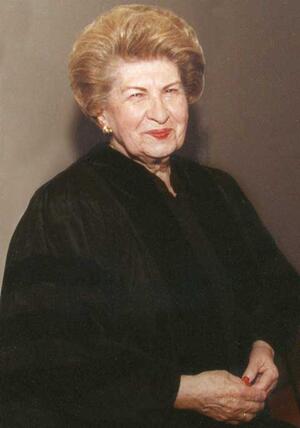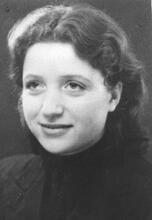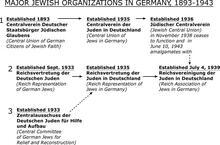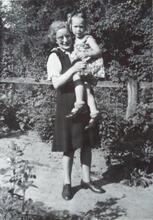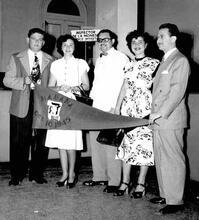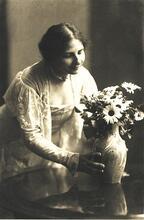Hadassah Rosensaft
A concentration camp survivor credited with saving the lives of thousands of Holocaust victims both during and after the war, and dedicated to preserving the memory of those who perished, Dr. Hadassah Bimko Rosensaft embodied the Jewish essence of the Holocaust in both its tragic and heroic dimensions.
Institution: Hebrew Union College-Jewish Institute of Religion
Dr. Hadassah Bimko Rosensaft suffered great loss at the hands of the Nazis, but she never gave up the fight to save the lives of countless Jewish men, women, and children in concentration camps and later displaced persons camps. Rosensaft studied in France to be a dental surgeon and worked in a dental clinic in Poland until the start of World War II, when she was deported to Auschwitz-Birkenau. In the camp, she worked in the infirmary and did all she could to help the ailments of her fellow inmates. Following the liberation of the camp in 1945, the deputy director of medical services of the British Army of the Rhine appointed Dr. Rosensaft to organize and head a group of doctors and nurses among the survivors to help care for the camp’s thousands of critically ill inmates. Dr. Rosensaft later provided key witness testimony to some of the first Nazi war crime trials. In 1980, President Jimmy Carter appointed Dr. Rosensaft to the United States Holocaust Memorial Council, and she was influential in ensuring the Holocaust survivor’s perspective was incorporated into the design of the Holocaust museum.
Background
Dr. Hadassah Bimko Rosensaft embodied the Jewish essence of the Holocaust in both its tragic and heroic dimensions. She experienced the full brunt of its horrors when her entire family was murdered by the Germans. Despite being subjected to tremendous physical suffering, she dedicated herself to helping her fellow concentration camp inmates, first at Auschwitz-Birkenau and then at Bergen-Belsen, and she is credited with having saved hundreds of lives in both camps. Immediately upon her liberation at Bergen-Belsen in April 1945, she worked alongside the British Army medical personnel in a desperate effort to save the lives of thousands of critically ill survivors. In September 1945, she was one of the principal witnesses for the prosecution at the first trial of Nazi war criminals. From 1945 until 1950, she was one of the leaders of the Jewish Displaced Persons in Germany and subsequently remained at the forefront of the survivors’ efforts to perpetuate the memory of the annihilation of European Jewry. Between 1978 and 1994, she played a key role in the creation of the United States Holocaust Memorial Museum in Washington, D.C.
Hadassah (also known as Ada) Bimko was born on August 26, 1912, in Sosnowiec, Poland. She studied dentistry at the Faculty of Medicine of the University of Nancy in France, was awarded the degree of Chirugien Dentiste (Dental Surgeon) in 1935, and returned to Sosnowiec where she worked in a dental clinic. On August 2–3, 1943, she was deported to Auschwitz-Birkenau together with approximately five thousand Jews from the ghetto of Sosnowiec. Her parents, husband, and five-and-a-half-year-old son were immediately sent to their deaths in the gas chambers.
Life in the Birkenau Infirmary
In October 1943, she was assigned by the notorious SS Dr. Josef Mengele to work in Birkenau’s Jewish infirmary, where she saved the lives of numerous Jewish women by performing rudimentary surgery, camouflaging their wounds, and sending them out of the barrack on work detail in advance of selections. In her memoirs, which she completed shortly before her death in 1997, she recalled that “women came to the infirmary with abscesses, furuncles, and wounds inflicted by dogs as well as from the whips of the SS guards who watched the women at work. We tried to help these women as much as possible. … The infirmary was not very well equipped. There were mirrors for looking into mouths and scissors to cut bandages. We had only some paper bandages, which looked like rolls of toilet paper, and a very few pills.” Because she had to obtain supplies from the SS pharmacy, she got to know some of the Jewish inmates who worked there and who “let me steal things from time to time. I stole such things as ether for anesthesia and aspirin. We didn’t have to steal the paper bandages” (Yesterday, 36).
Saving Lives
On November 14, 1944, Mengele sent her, together with eight other Jewish women, as a “medical team” to the concentration camp of Bergen-Belsen in Germany. In December 1944, a group of forty-nine Dutch Jewish children were placed in her care by SS guards, followed several weeks later by more Jewish children who had come to Bergen-Belsen from Buchenwald and Theresienstadt. One of the barracks was turned into a virtual children’s home for around 150 boys and girls ranging in age from infants to teenagers, all but one of whom survived. She organized a network of inmates who illicitly provided the children with additional food, medication and clothing. Hela Los Jafe, a fellow inmate, recalled that Ada Bimko “walked from block to block, found the children, took them, lived with them, and took care of them. … The children were very small and sick, and we had to wash them, clothe them, calm them, and feed them. That they survived was due to Ada Bimko and her helpers” (Ritvo, 181–182).
Aftermath of the Holocaust
When British troops entered Bergen-Belsen on April 15, 1945, they found more than ten thousand bodies scattered about the camp, and some fifty-eight thousand surviving inmates who were suffering from a combination of typhus, tuberculosis, dysentery, extreme malnutrition, and a host of other virulent diseases. Two days later, Brigadier H. L. Glyn Hughes, the deputy director of medical services of the British Army of the Rhine, appointed Dr. Bimko to organize and head a group of doctors and nurses among the survivors to help care for the camp’s thousands of critically ill inmates. For weeks on end, she and her team of twenty-eight doctors and 620 other female and male volunteers, only a few of whom were trained nurses, worked round the clock with the British military medical personnel to try to save as many of the survivors as possible. Despite their desperate efforts, the Holocaust claimed 13,944 additional victims at Bergen-Belsen during the two months after the liberation. Thirty-six years later, at the October 1981 International Liberators Conference organized by the United States Holocaust Memorial Council in Washington, D.C., Hadassah Rosensaft recalled the grim reality of her first days of freedom. “For the greater part of the liberated Jews of Bergen-Belsen,” she said, “there was no ecstasy, no joy at our liberation. We had lost our families, our homes. We had no place to go, nobody to hug. Nobody was waiting for us anywhere. We had been liberated from the fear of death, but we were not free from the fear of life” (Rosensaft 1999, 159–160).
In April–May, 1945, the survivors of the Bergen-Belsen concentration camp were transferred to the barracks of a nearby Panzer training school which became the Displaced Persons (DP) camp of Bergen-Belsen, the largest such camp in Germany. Within a month of the liberation, Dr. Bimko became a member of the Central Committee of Liberated Jews in the British Zone of Germany, heading its health department. In 1947, she was elected vice-chairman of the Central Committee’s Council, representing the Jewish communities and committees throughout the British Zone. She was the only woman in the senior leadership of the She’erit ha-Pletah, the Surviving Remnant, as the Jewish survivors of the Holocaust called themselves.
Eyewitnesses for Nazi War Crimes Trial
In September 1945 she was one of the principal witnesses for the prosecution at the first trial of Nazi war criminals before a British military tribunal held in Lüneburg, Germany. The defendants were commandants, doctors and guards of Auschwitz and Bergen-Belsen who had been arrested by the British at Bergen-Belsen. Her testimony, which was widely reported in the international press, constituted one of the first public eye-witness accounts of the atrocities and horrors that the inmates of both camps had been forced to endure.
Remembrance in America
On August 18, 1946, she married Josef Rosensaft (1911–1975), chairman of the Central Committee of Liberated Jews in the British Zone of Germany as well as chairman of the Jewish Committee of the Bergen-Belsen DP camp. Their son, Menachem, was born in Bergen-Belsen on May 1, 1948. Hadassah and Josef Rosensaft remained in the Bergen-Belsen DP camp until it was closed in 1950. After living in Montreux, Switzerland, for eight years, they settled in New York in 1958. Hadassah Rosensaft was one of the founders and officers of the World Federation of Bergen-Belsen Associations, serving as its honorary president after Josef Rosensaft’s death on September 10, 1975. In 1978–1979, she was one of only three Holocaust survivors and four women to serve on President Jimmy Carter’s Commission on the Holocaust. In 1980, President Carter appointed her to the United States Holocaust Memorial Council and in 1989 she was reappointed by President Reagan. A member of the Council’s Executive Committee, she chaired its Archives Committee until the end of her second term in 1994, and was influential in ensuring the integration of the survivors’ perspective into the design and content of the United States Holocaust Memorial Museum in Washington, D.C. In 1995, she was awarded an honorary doctorate by Hebrew Union College-Jewish Institute of Religion. She died on October 3, 1997, of liver failure resulting from malaria and hepatitis she had contracted at Birkenau.
Gill, Anton. The Journey Back from Hell: Conversations with Concentration Camp Survivors. London: William Morrow and Company, INC., 1988.
Goldsmith, Samuel Joseph. “Hadassah Rosensaft.” In Jews in Transition. New York: 1969, 107–111.
Lavsky, Hagit. New Beginnings: Holocaust Survivors in Bergen-Belsen and the British Zone in Germany, 1945–1950. Detroit, Michigan: Wayne State University Press, 2002.
Linenthal, Edward. Preserving Memory: The Struggle to Create America's Holocaust Museum. New York: Columbia University Press, 1995.
Pace, Eric. “Hadassah Rosensaft, 85, Dies, Saved Auschwitz Inmates.” The New York Times, October 8, 1997, B7, col. 1
Phillips, Raymond, ed. The Trial of Joseph Kramer and Forty-Four Others. London: William Hodge and Company, 1949.
Ritvo, Roger A. and Diane M. Plotkin. Sisters in Sorrow: Voices of Care in the Holocaust. College Station, Texas: Texas A & M University Press, 1998.
Rosensaft, Hadassah. Yesterday: My Story. Washington, D.C.: Yad Vashem and Holocaust Survivor's Memoirs, 2004.
Rosensaft, Hadassah. “The Children of Belsen.” In Belsen. Tel Aviv: 1957, 98–108.
Rosensaft, Hadassah. “Holocaust Survivor Hadassah Rosensaft Describes the Day She Was Liberated from a Nazi Extermination Camp.” In Our Own Words: Extraordinary Speeches of the American Century, edited by Senator Robert Torricelli and Andrew Carroll, 159–160. New York, Tokyo, and London: Washington Square Press, 1999.

